Chiquibul
National Park,
Belize |
 |
| Since
2002, Marcella
J. Kelly has been monitoring jaguars, pumas
and ocelots through remote camera surveys across
these two different habitat types in Belize with
a particular emphasis on jaguars. In collaboration
with other authors, this work has resulted in the
first density estimates for jaguars from remote
cameras (Kelly, 2003; Silver et al, 2004).
Jaguar estimates were highest from Belize at 7.5
- 8.5 per 100 square kilometers and lowest for
Bolivia at 2 - 3 jaguars per 100 square kilometers. |
| The
first survey for the pine forest habitat occurred
in 2004 and interestingly, jaguar numbers are
similar in this habitat compared to the broadleaf
forest. This is contrary to expectations which
were that jaguar numbers would be lower in the
pine forest and puma numbers would be much higher
in the pine forest. Ocelot numbers were much
lower in the pine forest than the broadleaf. |
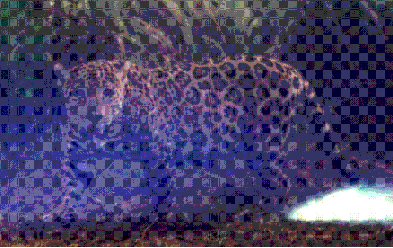 |
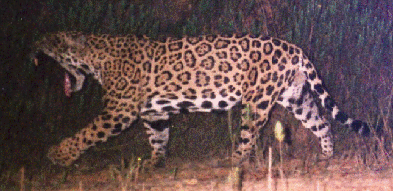 |
| One
interesting anecdote from the pine forest is
that there is one male jaguar that roams far
and wide and has been photographed at 16 of the
23 camera stations. |
He
has even been photographed at four different
stations in a 24-hour period. He is routinely
photographed at more than one station a day. |
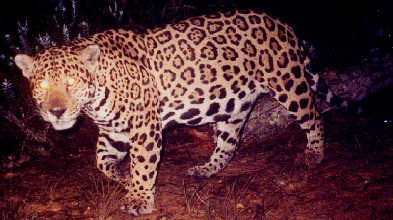 |
 |
During
the 2005 survey he was photographed 75 times in
just over two months. This guy gets around!
|
Note
the coat pattern is the same for all the left sides.
Coat patterns are like fingerprints and allow us
to individually identify each jaguar captured on
film. Also, note the gash on the right side of
his neck. This has already healed and is no longer
visible. |
|
Threats
Besides the general threats of habitat
loss and fragmentation that are occurring all over
the jaguar's range, the recent completion of the
Chalillo Dam on the Macal
River in Belize has been
an immediate threat to jaguars (and scarlet macaws)
in the area. (Note: Many argue this dam was constructed
illegally.) While the dam is not very large, it is
in a pristine area and opens up roads into the region.
Road construction likely means more hunting pressure
on prey animals and jaguars. Many believe that more
dams are on the horizon for the Macal River.
Since the Chiquibul forest is so close
to the border with Guatemala, there are frequent
threats from poachers that cross the border into
Belize. Interestingly, most of those poachers are
in Belize to take plants of the genus Chamaedorea (locally
known as xaté - pronounced sha-tay)
which are palms used in the flower industry. This
is a lucrative business and leaves can fetch $1 eachon
the international market. Teams of xateros (often
with horses) wokd the forest cutting most but not
all leaves of the palm. Some leaves are left in the
hope that the plant will recover and they can return
to re-harvest later. However, it is unclear whether
the plants do recover and whether they reproduce
after such cutting. While in the forest, the xateros will
hunt animals - both prey animals of jaguars and the
jaguars themselves. They also steal cameras. |
|
Solutions
The pods - a muddy affair
The stealing of cameras is a problem for
many remote camera studies. To combat this,
the Principal Investigator has recently received
funding from the Philadelphia
Zoo and Wildlife
Conservation Society to construct theft-proof
camera pods. These pods are made of concrete
which is mixed and poured into a form on-site.
Construction of the camera pods began in
July 2006. While a seemingly simple solution,
this has proven more difficult than anticipated.
The wet season hit hard in 2006 and being
stuck in the mud was par for the course beginning
in July. we counted 14 times that we could
remember being stuck this past field season.
But construction is well underway with
26 pods completed by August 2006 and 14 more
planned. Weight of each pod . . . roughtly
480 pounds. Try putting that in
your backpack! |
|
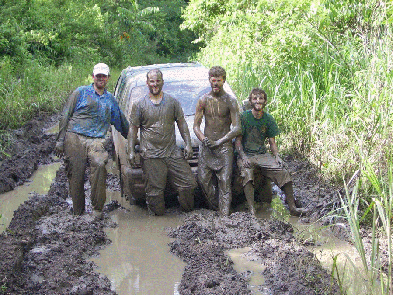 |
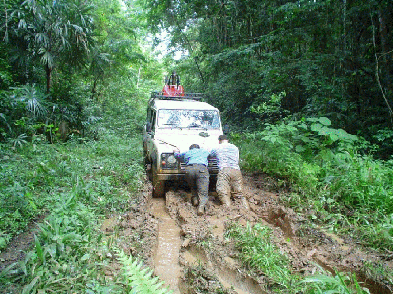 |
| Jason
Swenson, Eddie Owens and two unsuspecting volunteers
(Ollie and Jaime) attempting to get to the proper
location to construct a camera pod |
Jason
and Eddie once again put their muscles to work. |
|
|
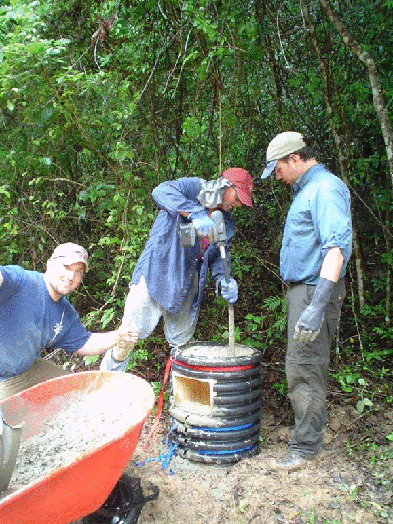 |
Marcella
and Tom loading a form with concrete. |
The
team looks on while Tom uses the concrete vibrator |
|
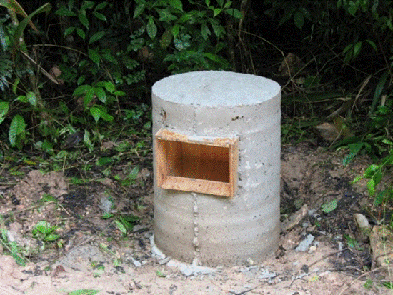 |
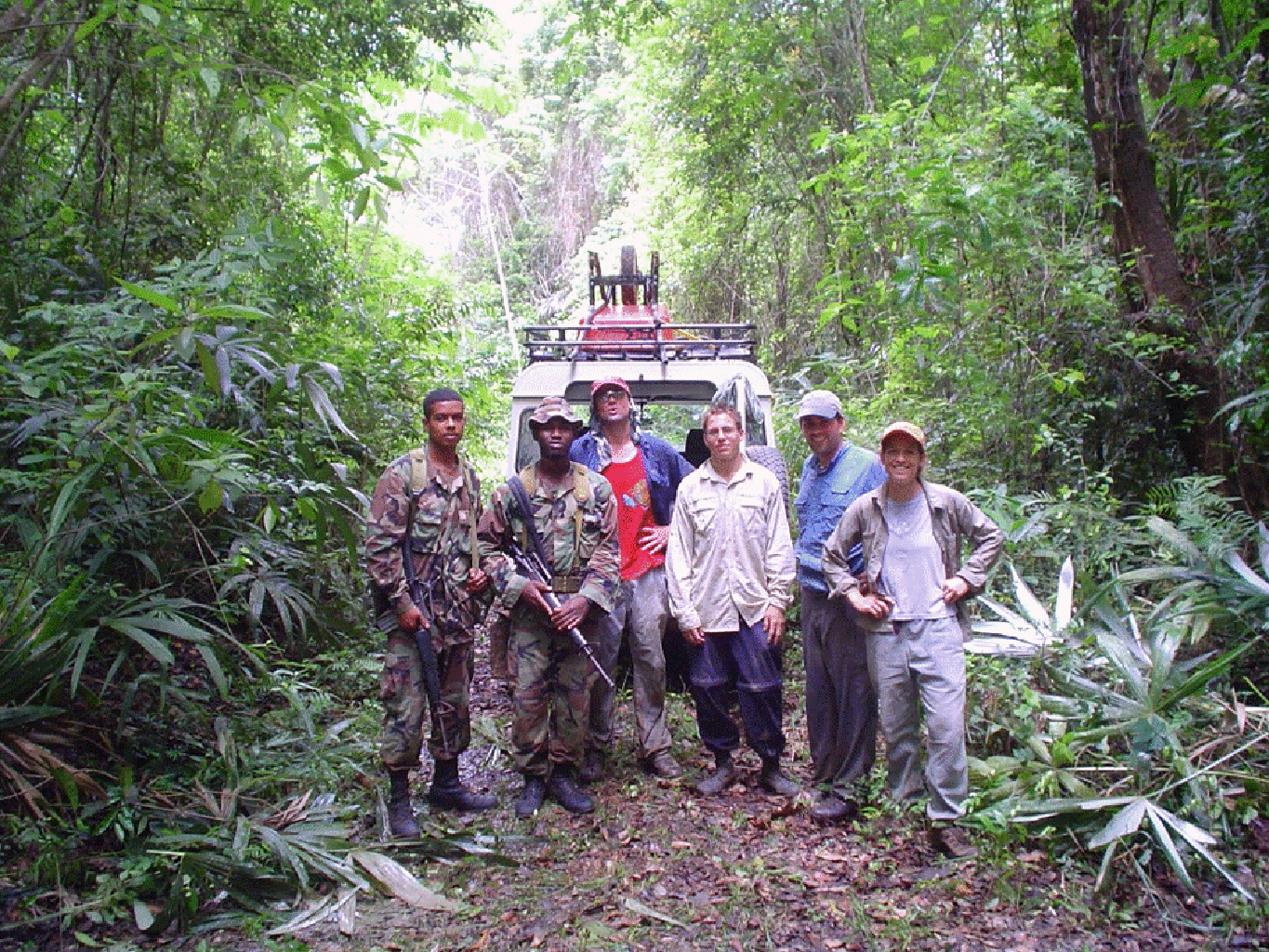 |
| The
completed camera
pod. Once the concrete
is cured, the wood
will be removed and
the cameras will
ber bolted into the
concrete, covered
with a steel camera
protector and locked
with a padlock. |
Some
members of the camera
pod team, pluse Belize
Defense Force soldiers
Ryan and Alvarez,
at the statrt of
a successful camera
pod building day
in July 2006. |
|
| |
|
Project
continuation
Camera surveys will continue
in the two habitats until critical information
about cats is determined. For example,
longevity of these cats in the wild is unknown.
Because
spotted cats are individually identifiable
by their coat patterns, over time this
study will yield new information on demographic
parameters such as lifespan, recruitment
(the number of young animals joining the
population), mortality rates and even movement
patterns. This information is vital to
conservation
and management of the species. |
|
| |
<

|

